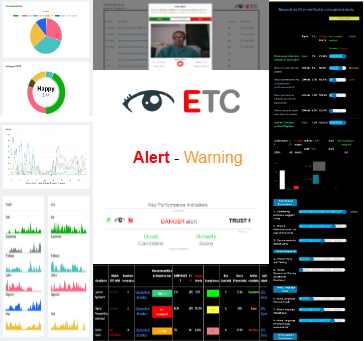ETC EMOTIONAL Fingerprint™ describes an individual’s unique emotional response to certain stimuli (questions) or situations. It is a concept gaining increasing attention in psychology, coaching, and psychiatry, as it provides a new way to understand and predict how people will react emotionally to different events in their lives.
The ETC EMOTIONAL Fingerprint™ is formed by a combination of factors such as past experiences, genetics, and personality. These factors shape an individual’s emotional response to different situations, making each person’s emotional fingerprint unique. For example, someone who has experienced a traumatic event in the past may have a different emotional response to a similar event in the present compared to someone who has not had that experience. Similarly, genetics can play a role in determining an individual’s emotional fingerprint, as some studies have suggested that specific genes may be associated with certain emotional traits or disorders. Finally, an individual’s personality can also influence their emotional fingerprint, as certain personality traits are often associated with different emotional responses.
Have you ever seen your EMOTIONS while answering questions?
Artificial Intelligence + Hard Data Metrics + Collective Human Perception = ETC AI Solutions
Microexpressions + Voice Intelligence + Transcripts (sources) to create Correlations, Emotional Interpretations & Alerts in Predictive Models.
ETC EMOTIONAL Fingerprint™can be used in different fields and industries, it can help professionals such as therapists, psychiatrists, and psychologists to understand their patients and to develop a treatment plan that is tailored to the individual’s unique needs. In the field of Candidates’ Hiring, Corp Climate, Innovation, sales & Profit improvement, marketing and advertising evaluation,, understanding an individual’s EMOTIONAL Fingerprint™ can help companies to develop more effective strategies for reaching and influencing consumers.
Additionally, in the field of education, understanding an individual’s EMOTIONAL Fingerprint™ can help teachers/coaches to understand the emotional needs of their students and to create an environment that is supportive and conducive to improving learning.
Moreover, ETC EMOTIONAL Fingerprint™ can be used to understand human behavior in general. It can help research and study the relationship between emotions and behavior. It can help policymakers to understand the emotional needs of their employees or citizens and to develop policies that are in line with these needs.
While the concept of the ETC EMOTIONAL Fingerprint is still relatively new, it has the potential to provide valuable insights into human behavior and emotional response. By understanding an individual’s unique emotional fingerprint, we can develop more effective ways to understand and predict how people will react to different situations and ultimately improve our ability to help them lead happier and more fulfilling lives.
ETC EMOTIONAL Fingerprint™ – Metrics
Metric Interpretation Guidelines:
Alert / Warning – Variations and correlations that are activated automatically can indicate a reaction that should be deepened with complementary questions.
P/N – Positive to Negative Emotions. It is understood as a correlation between the possible negative emotions that are registered vs. the positive emotions that are experienced result being the percentage higher means that the person has fewer negative alterations.
Danger Alert – Angers the rest of the emotions, which is indicative of a necessary deeper evaluation of the question by the examiner.
Soft Questions (Soft) – Hard (Specific or Research): to determine a base of answers that calibrate the emotional registers of the person throughout the examination.
TRUST f is the ratio of emotions P/N of the Hard questions over the Soft ones. The lower the percentage, the greater the need for examination.
Manual Metrics – Assigned by Examiner
Good Candidate – Examiner evaluation that is carried out on each question or value to achieve the qualification of the candidate.
Honesty Score is a collection of elements that we call “Checkpoints” that record a person’s bodily and verbal reactions when they are interviewed. Through detailed observation, it can be detected if they are lying. ETC Honesty Score.

In conclusion, ETC EMOTIONAL Fingerprint™ is a term used to describe an individual’s unique emotional response to specific questions, answers, or situations, which is thought to be influenced by various factors such as past experiences, genetics, and personality.
Understanding an individual’s ETC EMOTIONAL Fingerprint™ can help professionals in fields such as psychiatry, psychology, marketing and advertising, and education to develop more effective strategies for understanding and predicting human behavior. This concept is relatively new and has the potential to provide valuable insights into human behavior and emotional response. It can be used to understand human behavior in general and to develop policies that are in line with the emotional needs of people (ETC Solutions).
Microexpressions are brief, involuntary facial expressions that reveal a person’s genuine emotions.
These expressions occur when a person is trying to conceal their true feelings and are often difficult to detect. However, with proper training, it is possible to recognize these microexpressions and extract the emotions they reveal.
One way to extract emotions from microexpressions is through ETC facial recognition technology. This technology uses a computer normal camera and AI software to analyze a person’s facial expressions and identify specific emotions. This can be done in real-time, allowing for the immediate detection of microexpressions and the emotions they reveal.
Another method for extracting emotions from microexpressions is through the use of trained observers. These individuals have been trained to recognize microexpressions and the emotions they reveal through careful study and practice. They may use a variety of techniques, such as paying close attention to the eyes and mouth, to detect microexpressions and extract the emotions they reveal.
Regardless of the method used, extracting emotions from microexpressions can provide valuable information about a person’s true feelings. This can be useful in a variety of settings, such as Corporations, Law enforcement, Universities, Coaching & Psychology, and Business. In these fields, understanding the emotions of others can lead to more effective communication, decision-making, and improved outcomes.
In conclusion, extracting emotions from microexpressions can be a valuable tool for understanding a person’s true feelings. Whether through ETC facial recognition technology or trained observers, it is possible to detect and interpret these brief, involuntary expressions and gain insight into a person’s emotions.
The ability to extract emotions from Voice Phonetics.


